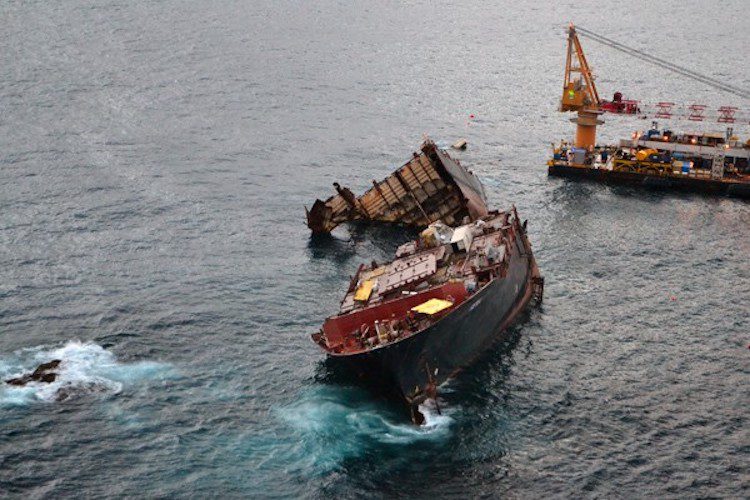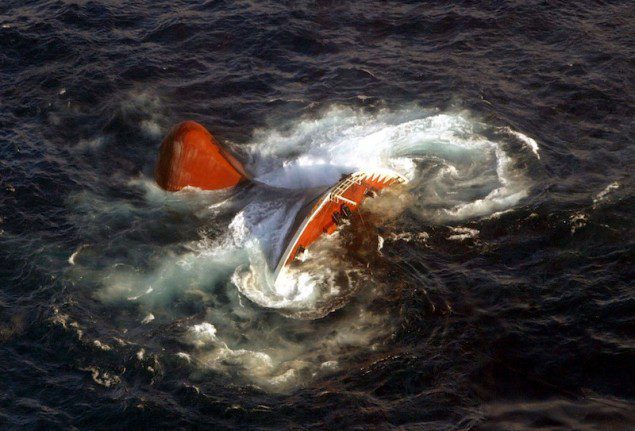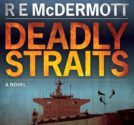Crew Rescued In Red Sea After Attack On Ship Near Yemen
CAIRO, July 6 (Reuters) – The crew of a ship set on fire in an attack in the Red Sea on Sunday abandoned the vessel and were rescued as it took on water, a British maritime agency said, in...


By Captain George Livingstone – Some of you may recall another phrase, “Call me Cassandra”. The term, originating in Greek mythology is used when valid warnings or concerns are either dismissed or disbelieved. In the space of just 90 days since my January column “2018 The State of Maritime” where concerns about modern maritime safety were discussed, there have been two serious maritime accidents involving some of the very considerations mentioned the column.

The first on Jan 7th involved a collision and fire between a loaded oil tanker and a bulk carrier 160 nm off the coast of China and the second occurring March 6 when a 15,000 TEU Maersk Honam ULCV (Ultra Large Container Vessel) caught fire in the Arabian Sea. There is no intent to point fingers or pass blame but rather to be a voice for international marine transportation safety. In that vein, a quote from my January column, “What about fire?” What happens on a 20,000 TEU mega ship when a fire breaks out in the middle of a container load? What if the ship is in port? What if it is in mid-ocean?” “The bible on modern marine firefighting, Rushbrooks Fire Aboard (edited by Dr. JF Lygate) states “Fire has not ceased to take its toll of ships and human life with the passage of time”. I go on to state, “a fire onboard one of the world’s new class of mega ship could lead to a fully recognized maritime disaster.”
In the first accident off the coast of China, the fully loaded oil tanker Sanchi collided with the bulk carrier CF Crystal 160 nm off the coast near Shanghai. Following the collision a spectacular explosion and fire occurred on the Sanchi killing all 32 crew members and eventually sinking the ship whilst spilling nearly 4,000,000,000 Gallons of Ultra-Light Crude into the waters of the area. To bring some perspective, that is 40% the size of the 1989 ‘Exxon Valdez’ oil spill’s 10,000,000+ gallons.
The crew members of the Sanchi were almost certainly killed in the explosion and the ship burned for days before sinking as there was no way to effectively fight a fire of that magnitude at sea. Oil spilled from the event eventually reached as far as Japan. A sad side note to this is the almost complete lack of news. Aside from the first week, there has been very little coverage, I find it incredible that this story seems lost to the dustbin and send thoughts and prayers to the family members left behind.
The second accident involved a fire aboard a house forward, 15,000 TEU Ultra Large Container ship. Once again, there is loss of life and the fire raged out of control for days after it started. It is fortunate the fire started in a forward container row, forward of the bridge superstructure as the ship’s bridge itself became a fire break. This contained the fire to the forward 1/3 of the vessel, how much worse could it have been if the fire had started aft of the bridge where most of the cargo was located?
The ship became a drifting hulk and although bad, it is not to be compared to the Sanchi collision and fire. Still, it raises the very concerns mentioned in my column regarding fires on ever-larger ships. It’s a legitimate question.
On March 12th, gCaptain covered some of the worst containership disasters in recent memory that is germane to this discussion. There have also been enough well-known tanker (1979 Bantry Bay, Ireland) and passenger ship (Costa Concordia) accidents to give us all pause. All the ships noted in gCaptain’s article are smaller by a significant measure as compared the ships about to be launched in the next several years.
So once again, how big is too big?
Perhaps it is only mariners who fundamentally understand the gravity of building ever bigger ships without serious safety studies? Few would argue that maritime trade is not vital to world prosperity. Should there not, however, be some kind of concerted, cooperative consideration and oversight when building ships that have never been seen on the ocean trades?
Whether passenger ship, oil tanker or container vessel, international discussions involving the IMO, class societies and maritime nations should be considered regarding ever bigger ships. If not, we all face the prospect of a future maritime disaster on a scale likely never seen before. Professional mariners watching all this unfold are beginning to worry, through no fault of their own, they will be easy targets for calamities that may occur on future mega ships.
Responsibility for international maritime safety starts from the top down, not the other way around. The safety of the marine environment and the lands surrounding it is in the hands of those who do business on great waters. Let us prove that stewardship has not been misplaced by having the courage to walk the walk and not just talk the talk.

Sign up for gCaptain’s newsletter and never miss an update

Subscribe to gCaptain Daily and stay informed with the latest global maritime and offshore news


Stay informed with the latest maritime and offshore news, delivered daily straight to your inbox
Essential news coupled with the finest maritime content sourced from across the globe.
Sign Up